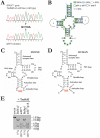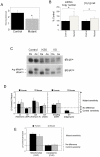Evolution meets disease: penetrance and functional epistasis of mitochondrial tRNA mutations
- PMID: 21533077
- PMCID: PMC3080857
- DOI: 10.1371/journal.pgen.1001379
Evolution meets disease: penetrance and functional epistasis of mitochondrial tRNA mutations
Abstract
About half of the mitochondrial DNA (mtDNA) mutations causing diseases in humans occur in tRNA genes. Particularly intriguing are those pathogenic tRNA mutations than can reach homoplasmy and yet show very different penetrance among patients. These mutations are scarce and, in addition to their obvious interest for understanding human pathology, they can be excellent experimental examples to model evolution and fixation of mitochondrial tRNA mutations. To date, the only source of this type of mutations is human patients. We report here the generation and characterization of the first mitochondrial tRNA pathological mutation in mouse cells, an m.3739G>A transition in the mitochondrial mt-Ti gene. This mutation recapitulates the molecular hallmarks of a disease-causing mutation described in humans, an m.4290T>C transition affecting also the human mt-Ti gene. We could determine that the pathogenic molecular mechanism, induced by both the mouse and the human mutations, is a high frequency of abnormal folding of the tRNA(Ile) that cannot be charged with isoleucine. We demonstrate that the cells harboring the mouse or human mutant tRNA have exacerbated mitochondrial biogenesis triggered by an increase in mitochondrial ROS production as a compensatory response. We propose that both the nature of the pathogenic mechanism combined with the existence of a compensatory mechanism can explain the penetrance pattern of this mutation. This particular behavior can allow a scenario for the evolution of mitochondrial tRNAs in which the fixation of two alleles that are individually deleterious can proceed in two steps and not require the simultaneous mutation of both.
Conflict of interest statement
The authors have declared that no competing interests exist.
Figures









Similar articles
-
Contribution of the tRNAIle 4317A→G mutation to the phenotypic manifestation of the deafness-associated mitochondrial 12S rRNA 1555A→G mutation.J Biol Chem. 2018 Mar 2;293(9):3321-3334. doi: 10.1074/jbc.RA117.000530. Epub 2018 Jan 18. J Biol Chem. 2018. PMID: 29348176 Free PMC article.
-
Isoleucyl-tRNA synthetase levels modulate the penetrance of a homoplasmic m.4277T>C mitochondrial tRNA(Ile) mutation causing hypertrophic cardiomyopathy.Hum Mol Genet. 2012 Jan 1;21(1):85-100. doi: 10.1093/hmg/ddr440. Epub 2011 Sep 26. Hum Mol Genet. 2012. PMID: 21945886
-
Functional and morphological abnormalities of mitochondria in human cells containing mitochondrial DNA with pathogenic point mutations in tRNA genes.J Biol Chem. 1994 Jul 22;269(29):19060-6. J Biol Chem. 1994. PMID: 7518448
-
Human mitochondrial tRNAs: biogenesis, function, structural aspects, and diseases.Annu Rev Genet. 2011;45:299-329. doi: 10.1146/annurev-genet-110410-132531. Epub 2011 Sep 6. Annu Rev Genet. 2011. PMID: 21910628 Review.
-
Human mitochondrial tRNA quality control in health and disease: a channelling mechanism?RNA Biol. 2012 Jan;9(1):33-9. doi: 10.4161/rna.9.1.18009. Epub 2012 Jan 1. RNA Biol. 2012. PMID: 22258151 Review.
Cited by
-
A Drosophila model for mito-nuclear diseases generated by an incompatible interaction between tRNA and tRNA synthetase.Dis Model Mech. 2015 Aug 1;8(8):843-54. doi: 10.1242/dmm.019323. Epub 2015 May 5. Dis Model Mech. 2015. PMID: 26035388 Free PMC article.
-
Mitochondrial biogenesis: regulation by endogenous gases during inflammation and organ stress.Curr Pharm Des. 2014;20(35):5653-62. doi: 10.2174/1381612820666140306095717. Curr Pharm Des. 2014. PMID: 24606800 Free PMC article. Review.
-
Pleiotropic effects of a mitochondrial-nuclear incompatibility depend upon the accelerating effect of temperature in Drosophila.Genetics. 2013 Nov;195(3):1129-39. doi: 10.1534/genetics.113.154914. Epub 2013 Sep 11. Genetics. 2013. PMID: 24026098 Free PMC article.
-
The emergence of the mitochondrial genome as a partial regulator of nuclear function is providing new insights into the genetic mechanisms underlying age-related complex disease.Hum Genet. 2014 Apr;133(4):435-58. doi: 10.1007/s00439-013-1402-4. Epub 2013 Dec 4. Hum Genet. 2014. PMID: 24305784 Review.
-
A Mutation in Mouse MT-ATP6 Gene Induces Respiration Defects and Opposed Effects on the Cell Tumorigenic Phenotype.Int J Mol Sci. 2023 Jan 9;24(2):1300. doi: 10.3390/ijms24021300. Int J Mol Sci. 2023. PMID: 36674816 Free PMC article.
References
-
- Jacobs HT. Disorders of mitochondrial protein synthesis. Hum Mol Genet. 2003;12:R293–301. - PubMed
-
- Chomyn A, Enriquez JA, Micol V, Fernandez-Silva P, Attardi G. The mitochondrial myopathy, encephalopathy, lactic acidosis, and stroke-like episode syndrome-associated human mitochondrial tRNALeu(UUR) mutation causes aminoacylation deficiency and concomitant reduced association of mRNA with ribosomes. J Biol Chem. 2000;275:19198–19209. - PubMed
-
- Enriquez JA, Chomyn A, Attardi G. MtDNA mutation in MERRF syndrome causes defective aminoacylation of tRNA(Lys) and premature translation termination. Nat Genet. 1995;10:47–55. - PubMed
-
- Hao R, Yao YN, Zheng YG, Xu MG, Wang ED. Reduction of mitochondrial tRNALeu(UUR) aminoacylation by some MELAS-associated mutations. FEBS Lett. 2004;578:135–139. - PubMed

